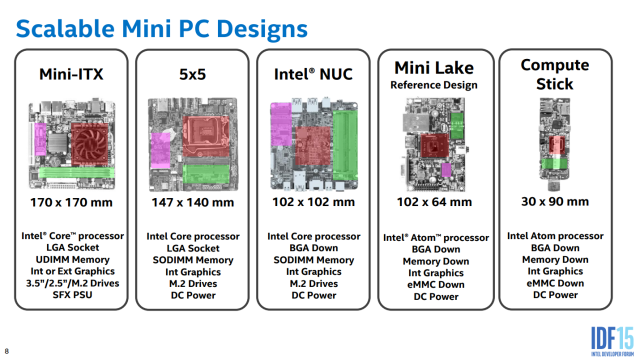
If you think mini-ITX is too big but don't like the soldered down processor of the Intel NUC, the chip giant has come up with a new form factor that splits the difference: 5×5.
Measuring, er, 5.5 inches by 5.8 inches (compared to the 4.5"×4.4" of the NUC, and the 6.7"×6.7" of mini-ITX), the new offering in many ways slides directly in between the form factors that bookend it. Like mini-ITX, it has an LGA socket compatible with Intel's Core-branded processors. But like the NUC, it uses SODIMM memory, M.2 drives, and an external power supply. It also sacrifices mini-ITX's PCIe slot. 2.5" SATA drives are also an option, though they will increase the system height a little.
So while the 5×5 leans much closer to the NUC spec list than the mini-ITX one, that processor and socket make a world of difference. The NUC processors top out at 28W for the Broadwell Core i7-5557U. Even that's something of an outlier; every other current generation NUC uses a 15W or 6W chip. The 5×5, however, will have two thermal targets: 35W and 65W. Though 65W systems will be a little taller to accommodate a larger heatsink, support for any Intel Core processor with a TDP up to 65W makes the system a lot more versatile. For example, the Broadwell Core i7-5775C is a 65W part. This powerhouse chip includes 128MB of eDRAM, and as a result it's surprisingly credible at gaming. This is a chip that can play Bioshock Infinite at 1920×1080 in high quality at 30 fps, Tomb Raider in low quality at 64 fps, and Dirt Showdown in medium quality at 46 fps.
OK, it's not going to to threaten high end discrete GPUs, but this kind of processor packed into the 5×5 form factor raises the bar on what a small system can do. Hitherto, mini-ITX was arguably the smallest system size that was credible for gaming or heavy workloads such as software development, graphics, and CAD. 5×5 will be able to serve many of those same markets, making it a compelling candidate for set-top-boxes and business workloads that push the limits of what the NUC can handle.
Equipped with 35W processors and an M.2 drive, 5×5 systems should come in at around 1.5 inches tall for a total system volume of less than 1 liter. 65W processors and 2.5 inch SATA drives will increase the height, though the system volume should remain significantly smaller than a comparable mini-ITX device.

These miniature systems require tight integration between the system chassis and the heatsink and cooling system, with the chassis often doing double duty as the heatsink. Intel is encouraging manufacturers to embrace copper in their designs. Although aluminum is substantially cheaper (about $1.6 per kilo, compared to copper's $5), copper's thermal performance is substantially better. The company described a fanless NUC-style device where the mid-section of the aluminum chassis/heatsink was redesigned to use a copper section. This reduced the processor temperature by 23 °C. The 5×5 spec not only governs the motherboard size and location of the mounting holes, but it's also the exact location of the processor. This kind of mixed material design can use the copper where it's most useful and stick to the cheaper aluminum elsewhere.
We've been fans of the Intel NUCs, but their limitations mean that they're not the best option for everyone. 5×5 looks like it'll be a compelling alternative: a little more size opening the door to potentially a lot more versatility. The expanding range of mini-PC form factors, from mini-ITX down to the compute stick, means that even more people should be able to find a mini-PC that suits their needs.
reader comments
63